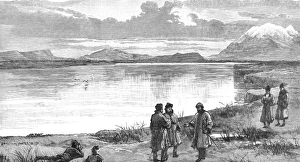Oxus Collection
The Oxus River, also known as Abu Darya or Amu Darya, holds a rich history and captivating beauty
All Professionally Made to Order for Quick Shipping
The Oxus River, also known as Abu Darya or Amu Darya, holds a rich history and captivating beauty. From its source in the Pamir Mountains to its delta in the Aral Sea, this mighty river has witnessed countless tales of conquest and exploration. Engravings depicting the lower course of the Oxus reveal a landscape intertwined with the Afghan Boundary Question and Russian presence in Central Asia. These images transport us back to a time when borders were contested and nations vied for control over this strategic waterway. One engraving showcases General Kaufmann's division crossing the Oxus during the Russian Expedition to Khiva, reminding us of daring military campaigns that shaped history. Another engraving highlights The Afghan Question, shedding light on geopolitical tensions surrounding this region. But it is not just conflict that defines the Oxus; it is also a treasure trove of ancient artifacts. The famous Oxus Treasure reveals exquisite gold bowls, jars, and amulets dating back to 5th-4th centuries BC. These precious relics offer glimpses into an opulent past where craftsmanship thrived along these fertile banks. Beyond human endeavors lies nature's splendor along the Oxus River. Lord Dunmore and Major Roches' expedition into Central Asia captured breathtaking lithographs showcasing Russia's connection with the Pamirs region through this majestic watercourse. As we delve into these hints from history - engravings capturing moments frozen in time or golden treasures whispering stories of antiquity - we are reminded that rivers like They can more than mere geographical features; they are conduits connecting civilizations across space and time.

























